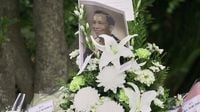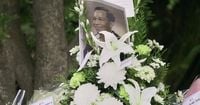On a solemn Saturday in Nagasaki, under a sky not so different from the one that bore witness to history’s most devastating moments, dozens of relatives of former Dutch prisoners of war (POWs) gathered to honor the memory of their loved ones. Their journey brought them to the site of the Fukuoka POW Camp No. 2, one of Japan’s largest World War II prison camps, where pain, loss, and—eventually—hope are etched into the very earth. This year’s ceremony held special significance, coinciding with the 80th anniversary of the atomic bombing of Nagasaki, a tragedy seen firsthand by many of the Dutch POWs imprisoned there.
The names of those who endured unimaginable hardship are engraved in a stone monument at the camp site, erected in 2015. According to the Associated Press, this monument was made possible through the contributions of Japanese survivors of the Nagasaki bombing and their descendants—a powerful symbol of reconciliation and peace. The event drew not just the bereaved families, but also Japanese citizens whose own histories are intertwined with the camp’s legacy.
Andre Schram, standing before the monument and the gathered crowd, spoke on behalf of the Dutch families. His words resonated with the weight of history and the promise of a better future: “It’s a plea for peace.” Schram continued, “It also stands as a symbol of reconciliation between those whose ancestors were once enemies.” His father, Johan Willem Schram, had been a Dutch Navy sailor. He survived three years of forced labor and privation at the No. 2 camp and witnessed the atomic bombing on August 9, 1945—just a week before Japan’s surrender. Andre Schram later published “Johan’s Story,” chronicling not only his father’s ordeal but also the broader context of the Netherlands’ colonial rule over the Dutch East Indies, the war with Japan, and the aftermath of World War II. Schram revealed that his father, overwhelmed by trauma, rarely spoke of his suffering while alive.
During World War II, Japan held about 150,000 Allied prisoners across Asia, with more than 30,000 in Japanese war prisons, according to the POW Research Network Japan. In Japan itself, these POWs were pressed into forced labor at mines and factories, filling the gap left by Japanese men drafted to fight across the continent. At the No. 2 Camp in Nagasaki, approximately 500 POWs—mostly Dutch, but also Americans, Britons, and Australians—endured harsh conditions. By the time the atomic bomb was dropped, more than 70 had already died from malnutrition, overwork, and illness. None at the No. 2 Camp died directly from the atomic blast, but their suffering was immense and ongoing.
The plutonium bomb that devastated Nagasaki was dropped at 11:02 a.m. on August 9, 1945. By the end of that year, over 70,000 people had died as a result of the bombing. The attack came just three days after the uranium bomb obliterated Hiroshima, which claimed the lives of 140,000 people. Japan’s surrender was announced on August 15, 1945, bringing an end to World War II and the nation’s nearly half-century of aggression in Asia.
For the POWs at the No. 2 Camp, the bombing was both a moment of terror and a harbinger of liberation. Situated about 10 kilometers (6.2 miles) from the hypocenter—the exact point above which the bomb exploded—the prisoners witnessed an apocalyptic sight. According to historians cited by the Associated Press, they saw “a huge orange fireball, purple smoke and the mushroom cloud rising from the direction of the city of Nagasaki.” The blast shattered windows, knocked doors off their hinges, and caused the clinic ceiling to collapse, injuring about 10 prisoners. At the No. 14 Camp, which was even closer to the blast, brick buildings were destroyed outright, killing eight and injuring dozens more.
In the days that followed, a sense of solidarity emerged among the survivors. Prisoners from the No. 2 Camp provided rice and other assistance to their fellow POWs from the devastated No. 14 Camp. The official notification of Japan’s surrender reached the POWs on August 18, and on August 26, a U.S. B-29 made the first food drop for the Allied prisoners. Finally, on September 4, just two days after the formal signing of the war’s end, the surviving POWs left the camp to return to their homelands, carrying with them memories that would haunt generations.
Saturday’s ceremony was not just a tribute to the past but a call to the future. Kazuhiro Ihara, whose own father survived the bombing and worked for reconciliation with former POWs, reflected on the ongoing significance of these gatherings. “We have been organizing this event with the hope that it will be a step towards achieving a peaceful world,” he said, adding that both the Dutch and Japanese “hope to further deepen our exchanges from now on.” The connection between the families of Dutch POWs and the descendants of atomic bombing survivors is, as Ihara put it, “very symbolic.”
The importance of remembering and learning from history was further underscored by the visit of Emperor Naruhito, Empress Masako, and Princess Aiko to Nagasaki the day before the ceremony. They paid tribute to the victims of the atomic bombing and met with survivors, emphasizing the necessity of telling the tragedy of war and drawing lessons for future generations. Their presence lent weight to the occasion and reminded all present of the enduring impact of war on individuals and nations alike.
The events at Fukuoka POW Camp No. 2, and the stories of those who endured its horrors, serve as a stark reminder of the costs of conflict. Yet, amid the sorrow, there is a persistent thread of hope—visible in the shared ceremonies, the engraved names, and the ongoing dialogue between former adversaries. The monument at Nagasaki is not merely a marker of loss; it is a testament to the possibility of healing and the power of collective memory to inspire peace.
As the world marks the 80th anniversary of the atomic bombings, the voices of survivors and their descendants echo through time, urging us to remember, reconcile, and strive—however imperfectly—for a more peaceful future.





